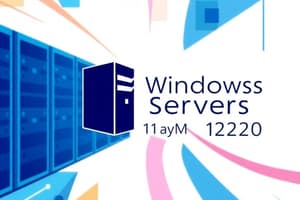Podcast
Questions and Answers
What architecture does Microsoft no longer provide for its server OS?
What architecture does Microsoft no longer provide for its server OS?
- 64-bit
- 32-bit (correct)
- ARM
- x86
Windows Server 2012/R2 installs both TCP/IPv4 and TCP/IPv6 by default.
Windows Server 2012/R2 installs both TCP/IPv4 and TCP/IPv6 by default.
True (A)
What is one consideration for naming a server in a new network?
What is one consideration for naming a server in a new network?
The server name must be unique and may include a description such as location or primary purpose.
The CPU architecture should support virtualization extensions if you want to run __________.
The CPU architecture should support virtualization extensions if you want to run __________.
Match the following hardware considerations for installing Windows Server 2012/R2:
Match the following hardware considerations for installing Windows Server 2012/R2:
Which of the following statements is true regarding IP addresses in Windows Server 2012/R2?
Which of the following statements is true regarding IP addresses in Windows Server 2012/R2?
Workgroups are more suitable for larger environments than domains.
Workgroups are more suitable for larger environments than domains.
What is a primary benefit of using a Read Only Domain Controller (RODC)?
What is a primary benefit of using a Read Only Domain Controller (RODC)?
What is the purpose of setting the correct time zone in a server environment?
What is the purpose of setting the correct time zone in a server environment?
Adding servers to a network is only necessary during company growth.
Adding servers to a network is only necessary during company growth.
A clean installation of an OS means it is installed on a new disk partition and isn't an ________ from a previous version.
A clean installation of an OS means it is installed on a new disk partition and isn't an ________ from a previous version.
Match the following server roles with their descriptions:
Match the following server roles with their descriptions:
What server role is suitable for reducing the amount of resources used in a virtual environment?
What server role is suitable for reducing the amount of resources used in a virtual environment?
What is important to ensure when performing a clean installation of Windows Server?
What is important to ensure when performing a clean installation of Windows Server?
The primary role of a Server Core in a branch office is to provide __________ for Active Directory.
The primary role of a Server Core in a branch office is to provide __________ for Active Directory.
Server roles determine how the server is used and what network services will be available to users.
Server roles determine how the server is used and what network services will be available to users.
Match the following reasons to add servers to a network with their descriptions:
Match the following reasons to add servers to a network with their descriptions:
What is the minimum password length required for the Administrator account during the installation of Windows Server 2012 R2?
What is the minimum password length required for the Administrator account during the installation of Windows Server 2012 R2?
Windows Server 2012 R2 must be activated within 30 days after installation.
Windows Server 2012 R2 must be activated within 30 days after installation.
Name one task that should be performed after the installation of Windows Server 2012 R2.
Name one task that should be performed after the installation of Windows Server 2012 R2.
The process of downloading and installing new drivers and service packs in Windows Server is called __________.
The process of downloading and installing new drivers and service packs in Windows Server is called __________.
Which of the following is NOT part of the postinstallation tasks for Windows Server 2012 R2?
Which of the following is NOT part of the postinstallation tasks for Windows Server 2012 R2?
Service packs contain only security updates.
Service packs contain only security updates.
A domain controller (DC) is a server that responds to __________ requests and verifies users on computer networks.
A domain controller (DC) is a server that responds to __________ requests and verifies users on computer networks.
How many times does the computer typically restart during the installation of Windows Server 2012 R2?
How many times does the computer typically restart during the installation of Windows Server 2012 R2?
Match the following terms with their definitions:
Match the following terms with their definitions:
What is one benefit of adding a second domain controller?
What is one benefit of adding a second domain controller?
What is a critical factor to consider for virtualization when planning a Windows Server 2012/R2 installation?
What is a critical factor to consider for virtualization when planning a Windows Server 2012/R2 installation?
Windows Server 2012/R2 supports the installation of both 32-bit and 64-bit processor architectures.
Windows Server 2012/R2 supports the installation of both 32-bit and 64-bit processor architectures.
What must the server name be in a new network installation?
What must the server name be in a new network installation?
Windows Server 2012/R2 installs both TCP/IPv4 and TCP/IPv6 by default, ensuring proper __________ within a network.
Windows Server 2012/R2 installs both TCP/IPv4 and TCP/IPv6 by default, ensuring proper __________ within a network.
Match the following hardware considerations with their descriptions:
Match the following hardware considerations with their descriptions:
What is one reason to add servers to a network?
What is one reason to add servers to a network?
A Read Only Domain Controller (RODC) is most beneficial for primary data centers.
A Read Only Domain Controller (RODC) is most beneficial for primary data centers.
What server role is appropriate for a branch office when remote administration is likely?
What server role is appropriate for a branch office when remote administration is likely?
Adding a server in a branch office can help reduce __________ traffic created by various domain functions.
Adding a server in a branch office can help reduce __________ traffic created by various domain functions.
Match the following reasons for adding servers to a network with their descriptions:
Match the following reasons for adding servers to a network with their descriptions:
What type of IP address is recommended for a server in Windows Server 2012/R2?
What type of IP address is recommended for a server in Windows Server 2012/R2?
A clean installation of an operating system is an upgrade from a previous version.
A clean installation of an operating system is an upgrade from a previous version.
What is an important consideration for server naming in a new network?
What is an important consideration for server naming in a new network?
A server should be assigned a _______ to ensure it is reachable within a network.
A server should be assigned a _______ to ensure it is reachable within a network.
Match the following server roles with their appropriate descriptions:
Match the following server roles with their appropriate descriptions:
Which of the following is a key advantage of using a domain over a workgroup?
Which of the following is a key advantage of using a domain over a workgroup?
Why is setting the correct time zone important for user authentication on a server?
Why is setting the correct time zone important for user authentication on a server?
What is the minimum number of characters required for the Administrator password during installation?
What is the minimum number of characters required for the Administrator password during installation?
Postinstallation tasks for Windows Server 2012 R2 include setting a static IP address.
Postinstallation tasks for Windows Server 2012 R2 include setting a static IP address.
What should you do if Windows does not activate automatically after installation?
What should you do if Windows does not activate automatically after installation?
A ________ is a server that responds to authentication requests on computer networks.
A ________ is a server that responds to authentication requests on computer networks.
Match the following Windows Server postinstallation tasks with their descriptions:
Match the following Windows Server postinstallation tasks with their descriptions:
How many times will your computer typically restart during the installation of Windows Server 2012 R2?
How many times will your computer typically restart during the installation of Windows Server 2012 R2?
What is the purpose of a service pack in Windows Server?
What is the purpose of a service pack in Windows Server?
Windows Update is used to download patches for security vulnerabilities.
Windows Update is used to download patches for security vulnerabilities.
To complete the installation, you will be prompted to set the Administrator _______ after installation.
To complete the installation, you will be prompted to set the Administrator _______ after installation.
Which of the following is NOT a postinstallation task for Windows Server 2012 R2?
Which of the following is NOT a postinstallation task for Windows Server 2012 R2?
Flashcards are hidden until you start studying
Study Notes
Planning a Windows Server 2012/R2 Installation
- Installation planning varies by network size—small networks need minimal decisions, while larger networks require careful integration planning.
- Hardware considerations include CPU type (AMD or Intel), up to 64 physical CPUs for servers, and the choice between 32-bit and 64-bit processors.
- Virtualization extensions are necessary for running Hyper-V.
- Research the disk subsystem technologies (FAT, NTFS) before installation.
- Unique server naming is required, incorporating descriptions related to location or purpose.
- Windows Server 2012/R2 installs both TCP/IPv4 and TCP/IPv6 by default; static IP addresses are recommended.
- Correct time zone settings are critical for user authentication.
- Choosing between workgroup or domain networks influences resource management and server capabilities.
Performing a Clean Installation
- A clean installation involves installing the OS on a new disk partition rather than upgrading; typically initiated via DVD.
- Ensure BIOS is configured to prioritize CD/DVD drive booting when installing.
- The installation process usually requires two system restarts.
- Post-installation, setting a strong Administrator password is mandatory, utilizing a mix of character types.
Postinstallation Tasks
- Activation of Windows Server 2012 R2 generally occurs automatically, needing completion within 10 days if not.
- Assign the correct date, time, and time zone, along with a static IP address and computer name.
- Enable automatic updates and install available updates promptly.
Installing Updates
- Patches and service packs address bugs and security vulnerabilities and are generally installed through Windows Update.
- A service pack consolidates all updates and fixes into a comprehensive package.
Expanding Your Network
- Deciding on server roles is crucial when adding a new server; it can be a domain controller (DC), read-only domain controller (RODC), or simply a member server.
- Reasons for adding servers include company growth, server load management, application isolation, and fault tolerance.
- Servers in branch offices can ease WAN traffic and improve authentication efficiency within the network.
Server Core Features
- Server Core is ideal for environments requiring minimal resource usage, such as secondary DCs, branch office servers, or single role servers (DNS, DHCP, etc.).
- It is not recommended for the first server installation, for tasks requiring extensive GUI use, or when the administrator lacks command-line experience.
Summary of Installation Process
- Most effort in installing Windows Server 2012/R2 is on planning, with DVD installations being standard for single-server setups.
- Essential postinstallation tasks encompass server naming, network configuration, and Windows Update management.
- Server roles can be installed after initial setup is complete.
Feature on Demand
- Feature on Demand allows the removal of Windows feature installation files from local storage, optimizing system resources.
Installing Windows Server 2012/R2
- Planning is essential; smaller networks require fewer decisions compared to larger ones which need detailed integration strategies.
- Hardware considerations for installation include CPU architecture (AMD or Intel), type of processors (workstation vs. server), and supporting up to 64 physical CPUs.
- Choose between 32-bit and 64-bit processors; Windows Server 2012/R2 only supports 64-bit.
- Virtualization extensions in the CPU are necessary for running Hyper-V.
- Disk subsystem research is critical to understand drive technologies like FAT and NTFS.
- Evaluate hot-add/hot-replace capabilities for adding memory or CPU without system downtime.
Installation Considerations
- Assign a unique server name that reflects its location or purpose for easy identification.
- Network protocols TCP/IPv4 and TCP/IPv6 are installed by default; assign a static IP address for server reliability.
- Correct time zone settings are crucial for user authentication processes.
- Decide between a workgroup or domain; workgroups suit smaller setups while domains offer more advantages.
- Server roles determine functionality and services provided to users.
Clean Installation Process
- A clean installation involves setting up the OS on a new disk partition, not upgrading from a previous version.
- Ensure BIOS is configured to boot from the relevant CD/DVD drive.
- Installation typically requires two system restarts and setting an Administrator password that meets complexity requirements.
- Upon completion, log in to Server Manager for further configurations.
Postinstallation Tasks
- Activating Windows Server 2012 R2 usually happens automatically; if not, activation is required within 10 days.
- Essential post-installation tasks include configuring date, time, static IP, computer name, and automatic updates.
- Download and install all available updates to secure the server.
Installing Updates
- Patches fix bugs and security vulnerabilities and can be installed via Windows Update.
- Service packs encapsulate all previous bug fixes and security updates, ensuring the server runs smoothly.
Expanding Your Network
- Adding a new server may involve making it a domain controller (DC) to enhance redundancy and load balance within an existing domain.
- A read-only domain controller (RODC) can be beneficial for branch offices, improving local authentication and reducing WAN traffic.
- Factors leading to server expansion include company growth, excessive server load, the need for application isolation, fault tolerance needs, and branch office demands.
Server Core Features
- Server Core configuration is suitable for secondary DCs, branch office servers, or roles like DNS and DHCP, optimizing resource usage.
- Avoid using Server Core as the first network server or if GUI tools are essential for management.
General Summary
- Windows Server 2012/R2 installation is straightforward but requires thorough planning and execution.
- Postinstallation setups involve naming the server, configuring network settings, selecting a network model, and updating the system.
- Additional servers within a network can serve various roles based on specific needs.
- Feature on Demand allows for the removal of unnecessary installation files, optimizing system performance.
Studying That Suits You
Use AI to generate personalized quizzes and flashcards to suit your learning preferences.




